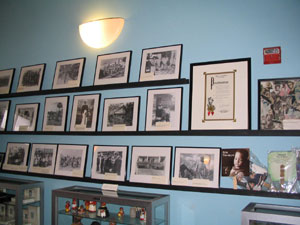After our interesting visits to the Orange County Regional History Center and the Well’s Built Museum of African-American Culture and History, we decided to continue our explorations of downtown Orlando and its surrounding historic neighbourhoods. After driving through beautiful residential areas, framed by majestic oak trees adorned by Spanish Moss, we decided to take a stroll around beautiful Lake Eola, which is just minutes from downtown’s Heritage Square, home of the Orange County Regional History Center, and every second, third and fourth Saturday of the month is also home to a lively farmer’s market. By this time, the sun was starting to set and Lake Eola and the surrounding highrises were bathed in the golden hues of sunset.

Lake Eola is one of Orlando‘s more than 300 lakes and is surrounded by established residential areas and highrises ringing the downtown core. The park extends over 43 acres (17.2 hectares) and provides generous sidewalks around the lake on a 0.9 mile (1.4 km) loop around the water, which is enthusiastically used by walkers and joggers. The lake itself can be explored on paddle boats, and other facilities include a playground, a small outdoor cafe, gondola rides, and the Walt Disney Amphiteatre for special events.

Lake Eola is intricately connected with Orlando‘s history. Even the origin of the name Orlando may be connected to Lake Eola: the first European settlements in the Orlando area grew around an old army post: Fort Gatlin. According to one story, a U.S. soldier by the name of Orlando Reeves, was killed by an American Indian’s arrow while on sentinel duty in what is today Lake Eola Park and may have given name to this town. Originally, Orlando had been called Jernigan after a Georgia settler, Aaron Jernigan, who settled in the area in 1843. The origin of the town’s name Orlando is not certain, however: another popular story claims that a certain Judge Speer named the settlement after the Shakespeare Character “Orlando” in the play “As you Like it.”

Be that as it may, the town was named “Orlando” in 1857 and was centered around the cotton and cattle industry. Demand for beef was fuelled by Cuba while cotton plantations thrived until the Civil War, which stole away the area’s workforce, compounded by a devastating hurricane in 1873. “Orange fever” hit Central Florida in the 1870s, aided by the completion of the South Florida Railroad in 1880.
The Great Freeze of 1894 to 1895 destroyed Florida’s citrus industry and it took 15 years to recover. Florida’s citrus industry peaked in the 1950s with more then 80,000 acres (32,000 hectares) of plantations.

Walt Disney Amphitheatre
Orlando’s first airport opened in 1922. Orlando also plays a significant role in the defense and aerospace industry: during World War II bomber pilots were trained here. A missile factory was built by in 1956 by a forerunner of the Lockheed Martin company, which still serves as the backbone of the area’s technology industry today.

Tourism became Central Florida’s main draw. From an early entertainment park in 1895, to the creation of the Cypress Gardens Adventure Park in 1936, the opening of Walt Disney World Magic Kingdom in 1971 really laid the foundations to Central Florida’s tourism boom. Other Disney attractions followed, including Walt Disney World Resort, Epcot, Disney-MGM Studies, and Animal Kingdom. Universal Studios Florida opened in 1990, followed by Islands of Adventure in 1999 and Universal City Walk, an entertainment complex.

Indeed tourism is Central Florida’s main industry today, with more than 50 million visitors annually and yearly revenues of $28 bllion. Tourism combined with high-tech and the citrus industry are the three dominating economic sectors in Central Florida.
After our walk around historic Lake Eola we strolled back into downtown and grabbed a table on the street patio of “Tijuana Flats”, a Mexican restaurant located right on Heritage Square, and just one of many diverse kinds of eating establishments in the downtown core.

While savouring some tasty and very filling Mexican food, we watched the early evening street life in Orlando‘s downtown. We reflected on how different the downtown area is in comparison to the newer and very spread out tourist-oriented hotel and resort areas, which often seem rather devoid of character. Here in the downtown area you really get a feel for the history and the community that started developing in the first half of the 19th century. The downtown and Lake Eola areas, all of which are on an easily walkable scale, have a much more authentic ambience to them which we thoroughly enjoyed.
For more information about Orlando contact the Orlando Convention and Visitor Bureau. The Orlando Regional History Center can be found at www.thehistorycenter.org.





